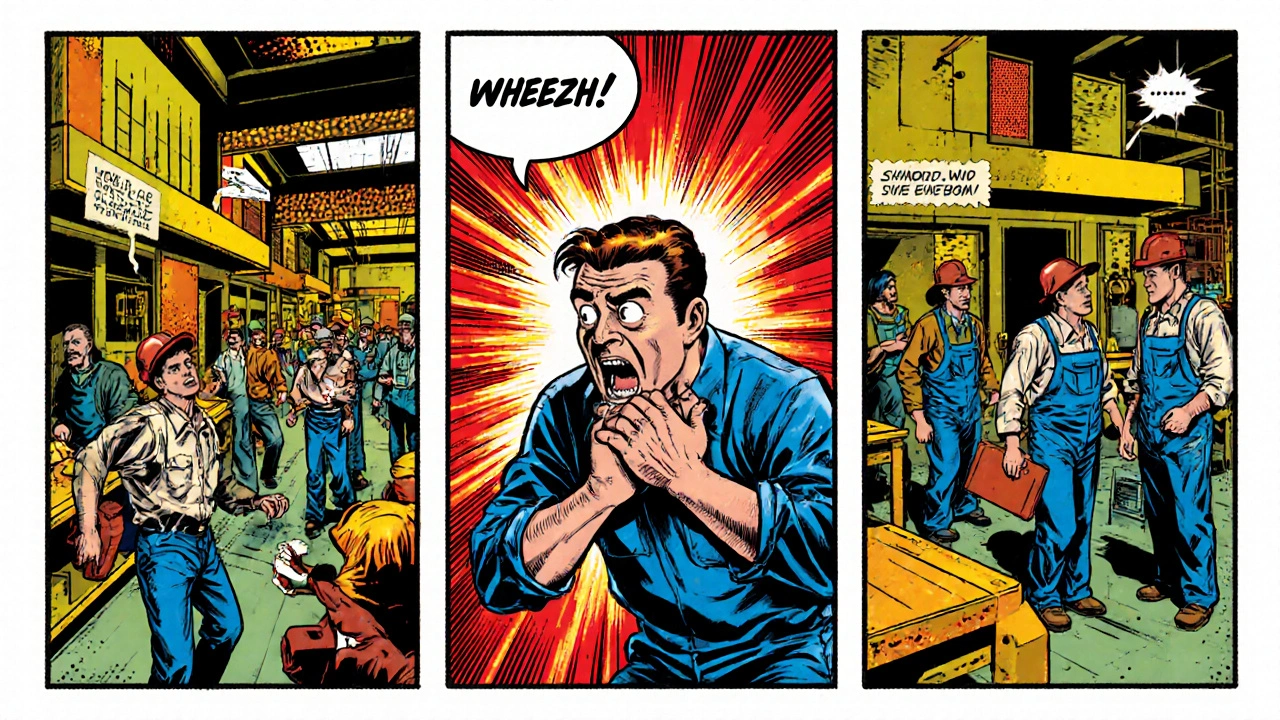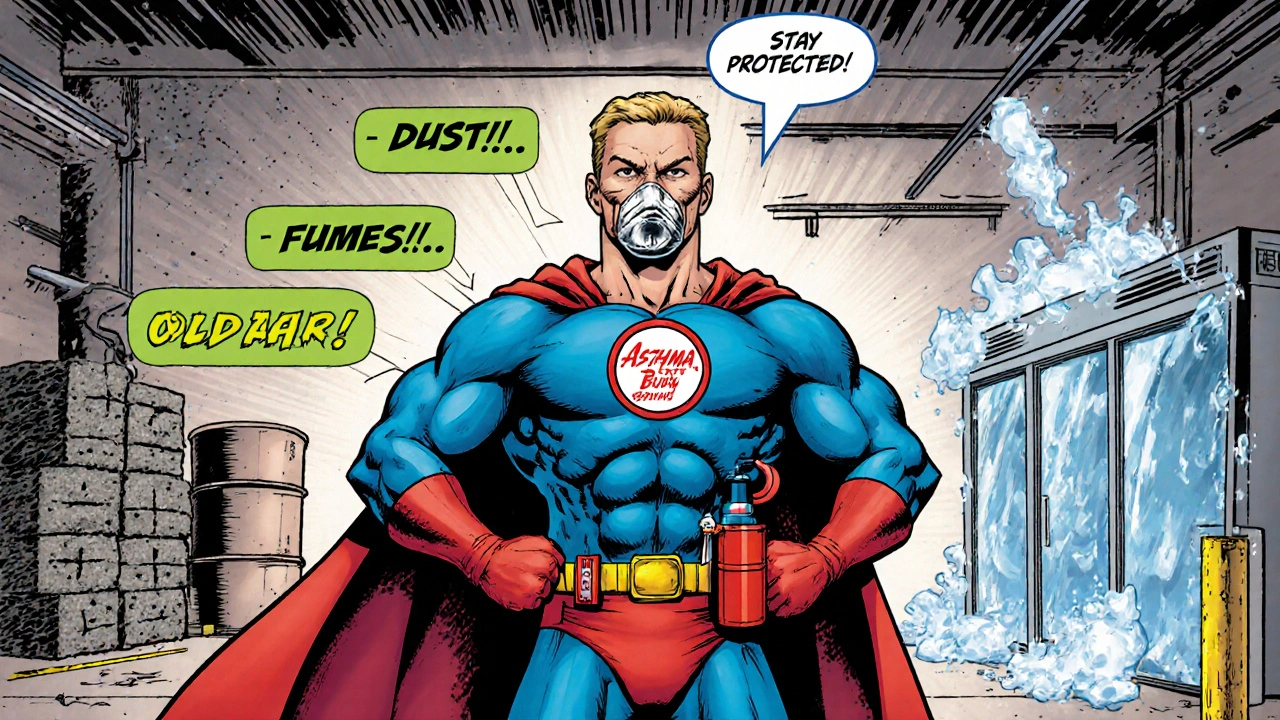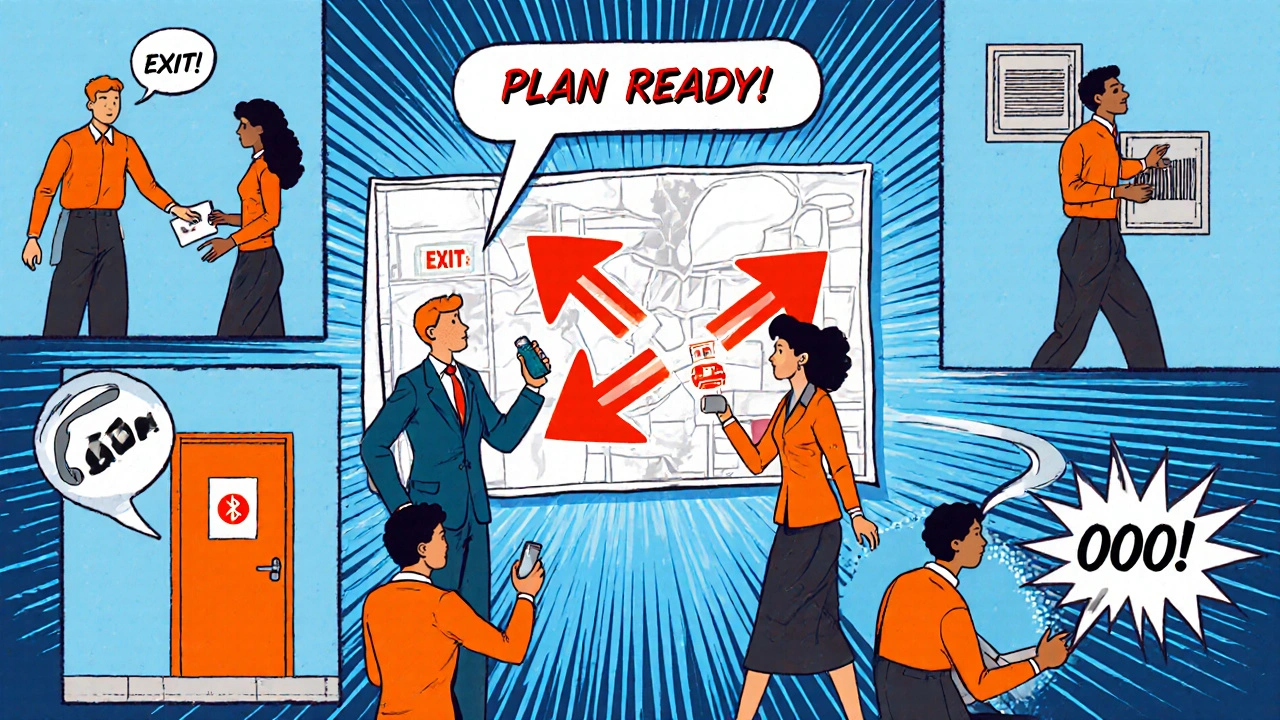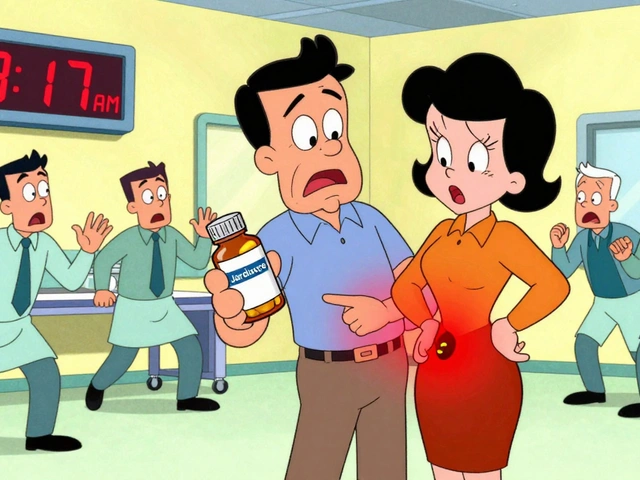
Workplace Asthma Control Measure Estimator
Control Measure Selection
Select the control measures you're considering for your workplace. This tool estimates costs and effectiveness based on industry-standard ranges.
Workplace Risk Assessment
Complete this brief assessment to identify potential asthma triggers in your work environment.
When you’re on the job, an unexpected asthma attack is a sudden tightening of the airways that can cause coughing, wheezing, and shortness of breath can feel like a nightmare. It often results from a mix of irritants, stress, or even a cold, and the workplace can turn a mild flare‑up into a full‑blown emergency. Knowing how to spot triggers, protect yourself, and act quickly can mean the difference between a brief pause and a dangerous episode.
Understanding Asthma and Workplace Risks
Asthma is a chronic inflammatory disease of the lungs. In lay terms, the airways become overly sensitive and swell when exposed to certain stimuli. Asthma affects roughly 339million people worldwide and is a leading cause of work‑lost days. When the condition shows up at work, it’s called occupational asthma, and it can be either pre‑existing asthma worsened by the job or asthma that develops because of workplace exposures.
The biggest risk factor is the environment you spend most of your day in. Poor ventilation, dust, chemicals, and even shifts in temperature can all tip the balance. If you’ve never had an attack before, the first episode at work can be especially alarming.
Common Workplace Triggers
Not every workplace is a minefield, but many industries have classic culprits. Below is a quick snapshot of triggers you’ll encounter most often:
- Dust including wood, flour, and metal filings
- Chemical fumes such as solvents, cleaning agents, and spray paints
- Biological allergens mold spores, pollen, animal dander in offices or labs
- Cold air often a trigger in refrigerated warehouses or outdoor sites
- Physical exertion heavy lifting or fast‑paced production lines
Even “invisible” factors like stress or poor indoor air quality can push a susceptible person over the edge.
Personal Protective Strategies
While employers have a duty to control hazards, you can also take steps that work in tandem with workplace controls. Here’s a practical checklist:
- Carry your reliever inhaler (bronchodilator usually a short‑acting beta‑agonist like albuterol) at all times. Keep it in a visible pocket or on a lanyard.
- Use a personal protective equipment (PPE) such as a properly fitted N95 mask when working with dust or fumes. Remember, a mask designed for respiratory protection is different from a simple surgical mask.
- Request a workplace health assessment from your occupational health service. They can perform a spirometry test to gauge lung function and track any decline.
- Stay hydrated and take regular breaks in fresh‑air zones. Even short “air‑reset” periods can lower exposure.
- Plan your route through the worksite to avoid high‑risk zones during peak activity.
These habits build a safety net that keeps you breathing easy even when a trigger slips through.

Creating an Emergency Action Plan
Having a plan is half the battle. An effective Emergency Action Plan (EAP) outlines who does what when an asthma attack occurs should include:
- Designated “asthma buddies” who know how to help and where the nearest inhaler is stored.
- Clear instructions to call emergency services (000 in Australia) if symptoms don’t improve within a few minutes of using the reliever.
- A location map showing the nearest medical facilities and first‑aid stations.
- Documentation of the employee’s specific triggers and medication regimen, kept confidential but accessible to the safety team.
Practice the plan with a drill at least twice a year. Repetition makes the response feel natural rather than frantic.
Employer Responsibilities & Legal Framework (Australia)
Under the Work Health and Safety Act 2011 and the accompanying regulations, Australian employers must provide a safe work environment. This includes:
- Identifying and assessing asthma‑related hazards through a formal Risk Management Process.
- Implementing control measures that follow the hierarchy: elimination, substitution, engineering controls (like local exhaust ventilation), administrative controls, and finally PPE.
- Providing training on how to recognize asthma symptoms and respond appropriately.
- Ensuring that any employee with asthma can access a suitable work area without discrimination, as guaranteed by the Disability Discrimination Act 1992.
Failure to meet these obligations can result in fines from Safe Work Australia and increased workers’ compensation premiums.
Practical Comparison of Trigger‑Control Options
| Control Method | Typical Example | Effectiveness* | Estimated Cost (AU$) |
|---|---|---|---|
| Elimination | Removing a solvent from the process | 90‑95% | Varies - may require equipment redesign |
| Substitution | Switching to water‑based paints | 70‑80% | 5,000-20,000 |
| Engineering Controls | Local exhaust ventilation (LEV) over a grinding station | 60-75% | 2,000-8,000 |
| Administrative Controls | Rotating staff to limit exposure time | 40-55% | Minimal - scheduling software |
| PPE | Fit‑tested N95 respirator | 30-45% | 50-150 per unit |
*Effectiveness reflects typical reduction in airborne irritant concentration when the method is correctly implemented.
While no single approach guarantees 100% safety, combining elimination with engineering controls and proper PPE offers the best protection.

Monitoring, Review, and Ongoing Management
Workplace safety isn’t a set‑and‑forget task. Establish a routine to keep the plan fresh:
- Quarterly air‑quality checks using portable particle counters.
- Annual health surveillance for employees with asthma, focusing on lung‑function trends.
- Incident debriefs after any asthma‑related event to spot gaps.
- Update the EAP whenever new equipment, chemicals, or processes are introduced.
By treating the plan as a living document, you give both the organization and the individual a real chance to stay ahead of flare‑ups.
Key Takeaway for Immediate Action
Start with one easy win today: talk to your supervisor about a formal asthma‑buddy system and make sure your reliever inhaler is always within reach. That simple habit alone can cut response time dramatically and give you peace of mind on the shop floor.
Putting these pieces together builds a robust safety net. Whether you’re a warehouse worker, a lab technician, or a manager drafting policy, asthma workplace safety is achievable when knowledge, personal readiness, and workplace controls work hand‑in‑hand.
Frequently Asked Questions
What should I do if I feel an asthma attack coming on at work?
Stop what you’re doing, move to a well‑ventilated area, and use your reliever inhaler as prescribed. If symptoms persist after two minutes, alert a coworker, call emergency services, and follow your Emergency Action Plan.
Can an employer force me to take medication at work?
Employers cannot compel you to take medication, but they must provide a safe environment and reasonable accommodations. This can include allowing you to keep your inhaler handy, adjusting tasks, or improving ventilation.
How often should workplace air quality be tested for asthma triggers?
A good rule of thumb is quarterly testing for dust and chemical concentrations, with additional checks whenever new substances or processes are introduced.
Are there financial incentives for businesses that improve asthma safety?
Yes. In many Australian states, businesses that implement proven health‑and‑safety upgrades can qualify for reduced workers’ compensation premiums and occasional government grants for ventilation upgrades.
What legal protections do I have if my asthma worsens because of work?
Under the Work Health and Safety Act and the Disability Discrimination Act, you have the right to a safe workplace, reasonable adjustments, and protection from termination due to a medical condition. You can also lodge a claim with Safe Work Australia if the employer fails to meet obligations.




Benjamin Hamel
October 15, 2025Look, anyone can throw together a checklist of inhalers and PPE, but the real issue is that most workplaces treat asthma like an optional inconvenience rather than a chronic condition that demands systemic change. You keep hearing about N95 masks and “air‑reset” breaks, yet the hierarchy of controls tells us that elimination and substitution should be the top priority, not a band‑aid approach. When you spend your day surrounded by dust clouds or volatile solvents, a mask is only as good as the fit, and the fit is only as good as the training you actually get – which, let’s be honest, most companies skim over. Moreover, the legal landscape in Australia, while robust on paper, often devolves into a checkbox exercise that doesn’t translate into on‑the‑ground safety. I’ve seen sites where the “asthma buddy” system is a line on a spreadsheet that nobody looks at until an incident happens, and then it’s chaos. The recommendation to carry a reliever inhaler everywhere is sound, but it’s also a reminder that we’re still reacting to failures rather than preventing them. Think about the cost‑benefit of installing proper local exhaust ventilation versus buying a batch of disposable respirators every quarter – the former saves money in the long run and protects everybody, asthmatic or not. Also, regular spirometry is great in theory, but the reality is that workers often skip appointments because they’re busy or fear being labeled “high‑risk.” The cultural shift needs to start with management genuinely valuing health data instead of treating it as a liability. And let’s not forget the psychological stress factor – stress itself can be a trigger, yet it’s rarely addressed in safety manuals. If you’re going to have an emergency action plan, make sure it includes mental health resources and not just a map to the nearest clinic. In short, stop putting the onus solely on the individual and start demanding that workplaces invest in engineering controls that truly mitigate hazards. The checklist is a start, but without a top‑down commitment, it’s just another piece of paperwork.
Christian James Wood
October 21, 2025Honestly, the whole “carry your inhaler” mantra is a nostalgic throwback to the 80s when personal responsibility was the only thing employers cared about. You’re basically being told to manage your own medical crisis while the company wallows in bureaucratic compliance nonsense. If you think a “buddy system” is a groundbreaking safety measure, you’ve never witnessed a real‑time response where a coworker panics, fumbles for a device, and ends up making the situation worse. The article glosses over the fact that many of these guidelines are just legal lip‑service designed to protect firms from lawsuits, not to protect workers. The focus on N95 masks is misplaced; you need proper respirators with fit‑testing, not a mask you bought off the shelf during a clearance sale. And let’s not pretend that quarterly air‑quality checks are sufficient – they’re a tick‑box that can be fabricated with a single reading. A truly safe environment would eliminate the hazardous agents at the source, not dabble with band‑aid measures that require constant vigilance from already over‑taxed staff. The legal references are a smokescreen; they give the illusion of protection while allowing companies to dodge genuine accountability. In practice, unless you have a union backing you, you’ll be left holding the inhaler and hoping for the best.
Rebecca Ebstein
October 27, 2025Honestly, this was super helpful! I love the idea of an "asthma buddy" – it makes me feel less alone on the shop floor. I'm definitely going to talk to my supervisor about setting one up and keep my inhaler in my pocket at all times. Thanks for the practical tips!
Artie Alex
November 2, 2025From a risk‑assessment perspective, the implementation of an asthma‑buddy protocol must be anchored in a robust standard operating procedure (SOP) that delineates roles, responsibilities, and escalation pathways. Failure to embed such mechanisms within the occupational health framework may result in suboptimal response times and increased morbidity. It is imperative to integrate continuous training modules, preferably leveraging e‑learning platforms, to ensure competency maintenance. Additionally, consider leveraging quantitative exposure metrics to calibrate the frequency of air‑quality monitoring, thereby aligning with predictive analytics models.
abigail loterina
November 8, 2025Great points! If you need help setting up a buddy system or figuring out the best mask for your job, just let me know – happy to share what worked for my team.
Roger Cole
November 13, 2025Sounds solid.
Krishna Garimella
November 19, 2025Think of the workplace as a living ecosystem where every element, from the ventilation system to the human mindset, interacts in a delicate balance. When we neglect one component, like proper air filtration, we disturb the harmony and invite chaos, which in the case of asthma manifests as sudden, debilitating attacks. Embracing a holistic view means we don’t just hand out inhalers and hope for the best; we redesign the environment, foster a culture of mutual care, and empower each worker to be both protector and protected. It’s a philosophy of shared responsibility that transcends the checklist and becomes a way of being.
nalina Rajkumar
November 25, 2025👍 love the vibe here! 😊
Michael Barrett
December 1, 2025In truth, the dichotomy between "personal responsibility" and "employer obligation" is a false binary; the optimal solution resides in a synergistic integration of both. Nevertheless, the propensity of management to default to minimalist compliance stems from a cost‑benefit analysis that undervalues long‑term health outcomes. Therefore, a paradigm shift is required: moving from reactive mitigation to proactive elimination of airborne contaminants. This aligns with the hierarchy of controls and offers a statistically significant reduction in occupational asthma incidence.
Keri Henderson
December 7, 2025Spot on, Krishna. Your holistic take is exactly what we need to push forward. Let's champion those engineering controls and get management on board – the data backs us up.
elvin casimir
December 13, 2025Honestly, most of this is just a fancy way of saying "pay attention" – which any decent worker can do without a thousand pages of bureaucratic fluff. If you don’t like the air, complain, and maybe the boss will fix something. Stop overcomplicating it.